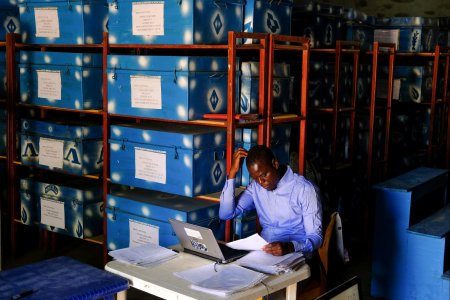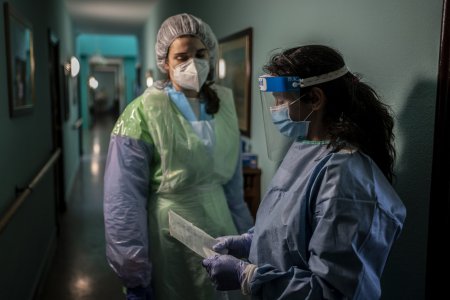
An epidemiologist’s analysis of the Covid-19 crisis - Part 2
Emmanuel Baron & Elba Rahmouni
Crisis situation, response strategies, hydroxychloroquine, interventional epidemiology and the state of scientific research in Africa: Elba Rahmouni interviews Emmanuel Baron, Director of Epicentre, Médecins Sans Frontières
The first part of the interview is available here.
Interventional epidemiology
How should we interpret the avalanche of statistics?
There are two difficulties here: there are too many statistics and they are unintelligible. We are given huge quantities of statistics, but most of them are a very flimsy. This profusion has encouraged numerous journalists, bloggers and statisticians to make their own calculations, recycling the same data and reproducing it in different forms. Thus, pie charts are turned into squares, rectangles into graphs, etc., all saying the same thing, while the essential data, such as the real number of cases or fatalities, is missing. But it is difficult to avoid this profusion because without public data, the population would be up in arms about the lack of transparency.
The second difficulty is making existing data intelligible so that it can be used to explain how the epidemic is evolving. Every day, the Health Directorate announces figures – partial for that matter - on the actual number of cases and deaths. But this data is given to us raw, with no explanation and no curves to help us put them into perspectives. A rate is a difficult notion to understand, but at least it provides us with a means of comparison and allows us to adapt decisions at a local level. The authorities have asked the population, who - as I said earlier - are key players in the response, to respect the lockdown without providing the pedagogy needed to explain the figures.
Is it useful to compare data from different countries?
It seems to me that the majority of countries have responded to the inflow of cases according to the same principle: reducing transmission through social distancing. But some have used moderate measures to achieve this, while others have imposed a tough lockdown. In countries such as Sweden, Switzerland or Germany, people were not required to self-isolate but have tended to do so spontaneously.
It is not useful to make comparisons based on weak (or unreliable) data taken out of context. And they are very often worthless because different countries have used different methods to report cases or fatalities. Today, we are seeing major disparities: the mortality rates in Belgium are twice as high as in the Netherlands; Portugal and Spain, despite being neighbours, are in incomparable situations; Switzerland has large infection sites along its borders but hasn’t been submerged by the disease, and the east of Europe has less affected than the west. There is no single mysterious explanation for all this. Possible contributory factors are the date and nature of the measures taken, personal and professional travel, ways of life, population density, different age structures, random travel, encounters and interactions and collective events organised (such as the gathering in Mulhouse in France). But we don’t really know the extent to which each of these factors contributes towards the differences seen within a country, between countries and between continents. And I think it’s a shame that our social scientist colleagues haven’t been asked to contribute more towards clarifying this point. As if only biomedical explanations are the only ones that count.
What can emergency epidemiology contribute?
It’s difficult, but the role of epidemiology is to describe and explain situations in real time. To use an old but still pertinent definition, epidemiology describes a situation in terms of time, place and person based on data collection and analyses. We start by providing some simple explanations. Who is affected? Since when? And where? This requires investigation; we have to “go out and find the cases”. In the epidemics that we work on with MSF, this is our most important task. Guiding the action by monitoring the trends is the primary function of our epidemiologists in the field. Epidemiological surveillance is a difficult activity whatever the country. We do everything in our power but we must acknowledge our limits. All surveillance systems do things to excess, by default, late, imprecisely. We can never be very precise.
Epidemiologists can be asked to study something in more depth to provide an answer to a specific question. For example, on Covid-19 in France, if studies had been able to determine where and how people were being contaminated during the lockdown, recommendations could have been made on how to strengthen protective measures. I haven’t seen anything along these lines so far.
What is the purpose of epidemiological models?
Models can be useful, provided we don’t see them as the be all and end all. It’s easy to understand their attraction because it’s natural to look to the future and want to know what’s going to happen in the coming months. But models don’t have this power. Their results should always be clearly explained. When models are delivered without explanation, there is a high risk that they will be reduced to data that is broadly communicated and interpreted. When in fact a model is more than a set of figures: it’s a process and an approach.
The usefulness of models lies in the fact that, on the scale of a whole continent, it is impossible to test different solutions on different populations to determine which measures are the most effective. For obvious reasons, including, if nothing else, that the initial epidemiological situations are very different, we can’t decide for example, that Germany will close its schools, France will go into lockdown, Italy won't impose any measures, Spain will only impose lockdown in the worst-affected provinces and the United Kingdom will only ban travel and close public spaces - and then, in two months’ time, see who controlled the outbreak the most effectively. This kind of study is unthinkable. What we can do is artificially recreate a fictional population, “impose” parameters of contamination, disease development and recourse to healthcare observed in real lifeHence the need for real, good-quality data.on this fictional population and then calculate the impact of these scenarios on the disease’s evolution, at different dates. Obviously, there is a great deal of uncertainty involved, and this uncertainty increases the further forward we look. And, what’s more, without accurate data from the countries (for example, the proportion of comorbidities among the population in the Democratic Republic of Congo), it is difficult to constitute a fictional population and scenario, adding even more uncertainty.
At the end of the day, modelling introduces quantitative data and reasonable orders of magnitude into the discussion. Models offer a framework for our operational discussions, but they don’t provide direct solutions. When discussing operational strategies at MSF and Epicentre, we consider models as an additional element to be combined with the common sense and experience of our field colleagues, for example. Just as it’s not the weather forecaster who decides whether a plane should take off, it is not the modeller’s job to decide on public health measures.
Wouldn’t it be better to use gross mortality rate compared to the same time last year and in comparable areas as a severity indicator?
Yes, that would be a pertinent indicator, and INSEE (France’s national institute for statistics and economic studies) has already established very high increases in the overall mortality rate of the Grand Est and Ile-de-France departments. But this rate doesn’t give us the causes of these deaths, and it’ll take several months to gather this information. There are people who have died of a heart attack this year who would have survived the same heart attack last year, for example. This data concerning the causes of deaths is essential and needs to be modelled to give us a clearer picture on which to base future decisions.
It would appear that, in France, we find it hard to plan for our seniors becoming victims in a health disaster. The 2003 heatwave is a perfect example of this. The initial figure of 11 000 mortalities was corrected to 15 000 a few months later, and then to 19 500 fours years afterwards. This is edifying when we consider the short period over which this event occurred. It may be socially acceptable for an elderly person to die in winter of a complicated infection, but there is nothing acceptable, in my opinion, about letting people die of avoidable causes because they are alone in August and forget to drink. Surveillance has since been put in place by the town halls. Yet today, once again, nursing homes are taking a heavy toll, with elderly people representing almost half of the deaths caused by Covid-19 and identified.
Scientific research in Africa
What can be said about the controversyhttps://www.youtube.com/watch?v=GKajchR7Gg8&feature=youtu.be&app=desktopcaused by the comments made by Jean-Paul Mira and Camille Locht on 2 April regarding clinical trials in Africa?
People were hurt by these comments and the authors have apologised. So there’s nothing more to say about this very clumsy, overly mediatised conversation, the real meaning of the comments or the authors’ actual intentions. On the other hand, the issue of scientific research in Africa is a real one that we are familiar with at Epicentre and I think it is important to talk about it in order to make a few things clear.
What is the state of research in Africa?
There are very many researchers in Africa, African and foreign, as well as numerous scientific training programmes and centres of excellence in the field of research, including the Kenyan Medical Research Institute (KEMRI) in Nairobi, the Centre for Vaccine Development in Bamako, the Uganda Virus Research Institute in Entebbe and the Centre de recherche médicale et sanitaire in Niamey. The context has evolved enormously. For example, in its 2016-2021 strategic plan, KEMRI states its intention to conduct phase 1 vaccine studies, i.e. to carry out the first trials with humans, so as not to be held back by slow research in the North. You need to look at what these researchers are doing and what they are publishing in high-level scientific journals to realise how much high-quality research is being done in Africa. And of course, all clinical trials to demonstrate the effectiveness of a treatment or vaccine are carried out according to the same ethical and scientific standards as in the North. Ethical committees are consulted prior to each study. There may be some shoddy studies, often under the influence of industrialists, which are methodologically weak and non-essential. But this is a universal problem, in no way specific to Africa.
Are enough studies carried out on the African continent?
In relation to the rest of the world, there are far fewer trials in Africa as many vaccines and drugs are not developed to address the health priorities of Southern countries or the conditions in which they practice medicine. In an editorial published on 8 April, entitled « Non, l’Afrique n’est pas, ni de près ni de loin, la cible privilégiée des essais cliniques » [No, Africa is not by any stretch of the imagination the preferred target for clinical trials], the Cameroonian researcher Fred Eboko stated that too few clinical trials are conducted in Africa and that, ‘Africans may be guinea pigs, but less so than anyone else”. To accelerate Covid-19 clinical research in countries with weak health systems and limited resources, especially in Africa, a coalition was created at the beginning of April and Epicentre has joined.https://www.thelancet.com/journals/lancet/article/PIIS0140-6736(20)30798-4/fulltext
Why is it important to do trials specific to Africa?
Studies that are not conducted in Africa cannot be conducted anywhere else in the same conditions. Indeed, the immunological and demographic profiles tested in clinical studies conducted in Europe (notably age) are not the same as those of the African population. And the vaccines and drugs tested will not necessarily be available or easily accessible in Africa. Trials have to be carried out in accordance with the medical, sociological and demographic environment in which the vaccine or drug concerned will be prescribed. In other words, trials carried out in Europe are not always adapted to the African context.
Examples?
The Epicentre study carried out in Niger in partnership with the Ministry of Health resulted in WHO’s recognition of the usefulness of a vaccine for rotavirus (primary cause of death by diarrhoea in young children) specifically adapted to the context of Sub-Saharan Africa as not requiring a cold chain. The manufacturers of existing vaccines in the North had not taken this major logistical issue into consideration.
Another example of constraints, this time linked to the health system itself: managing the monoclonal antibodies currently being tested in the North for the treatment of Covid-19 requires technical competences that often don’t exist in African settings. Consequently, if there are no clinical trials for this type of drug in Africa, large-scale use of these drugs will not be possible.
Finally, the epidemiological constraints are not the same. At Epicentre, we are looking to conduct a study with several African research groups that will lead to the inclusion in the vaccine schedule of a vaccine active against all the strains of bacteria responsible for meningitis epidemicsCurrently only a vaccine against the meningococcal strain A is available for the meningitis belt . If the studies required are not carried out in Africa, they won’t be conducted anywhere because this is not a priority for Northern countries, much less affected by these strains of the disease.
To conclude…
Looking at these three examples, we seem to have two choices: we either maintain the status quo and pray that, by chance, medical innovations will correspond to Africa’s specific requirements, or, through well-run studies, we draw attention to the limits of the current pharmaceutical R&D paradigm. The Covid-19 pandemic offers a new opportunity to lobby leaders. I think that some of them have understood, considering the commitments made on universal access to diagnostic tests, vaccines and therapeutics at the behest of WHO. But they will be judged by their deeds.
To cite this content :
Emmanuel Baron, Elba Rahmouni, “An epidemiologist’s analysis of the Covid-19 crisis - Part 2”, 11 mai 2020, URL : https://msf-crash.org/en/blog/medicine-and-public-health/epidemiologists-analysis-covid-19-crisis-part-2
If you would like to comment on this article, you can find us on social media or contact us here:
Contribute




Add new comment